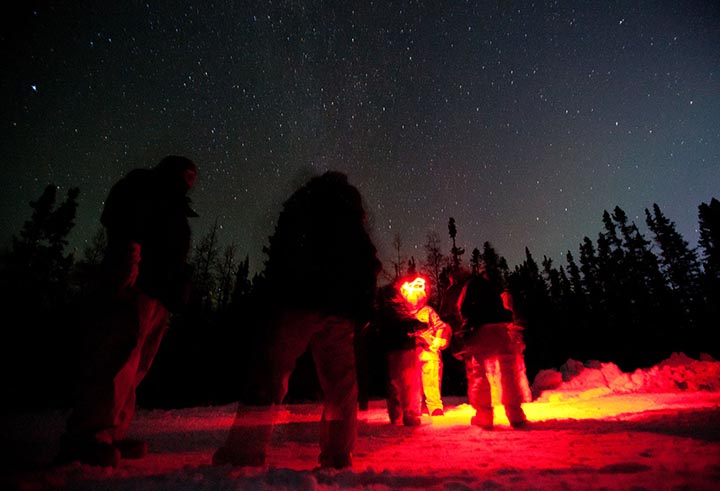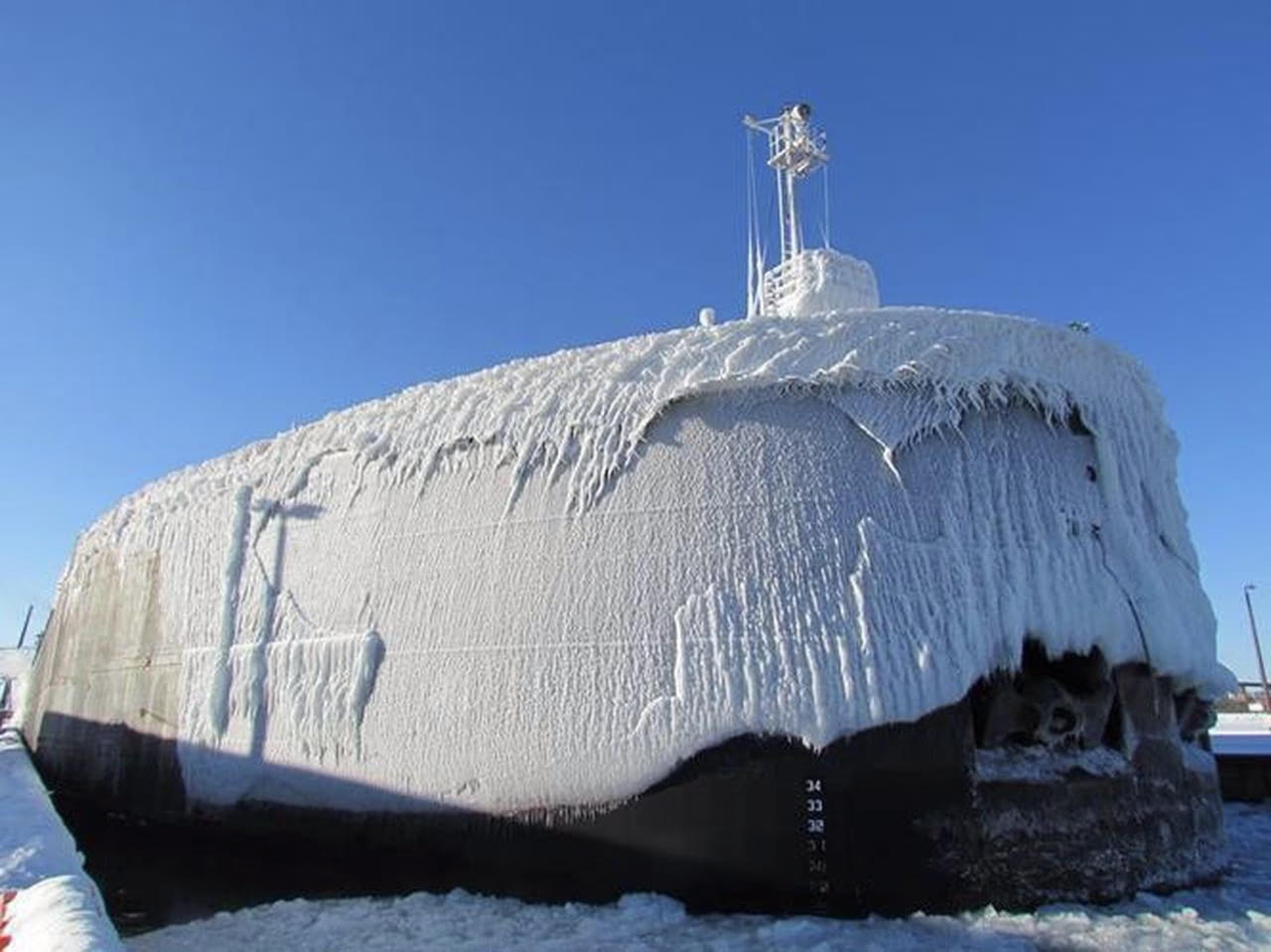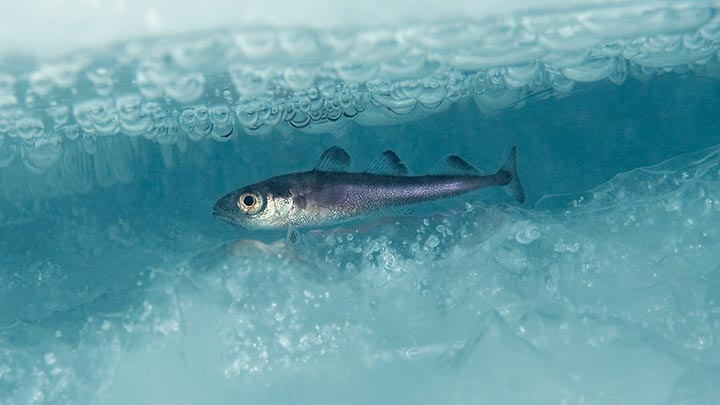Newswise — In February 2016, 215 soldiers from the U.S. and Canadian militaries conducted a 10-day exercise called Arctic Ram. Their objective was to demonstrate they could rapidly respond to an emergency in the Arctic. In this case, they simulated retrieving a military satellite that crash-landed north of the small town of Resolute on Cornwallis Island in Nunavut, Canada.
Dressed in winter whites and carrying up to 210 pounds (95 kilograms) on their backs, 65 of the soldiers leaped from two Hercules aircraft into the dusk-lit sky. They parachuted 1,250 feet (380 meters) onto the snowpack below, where the rest of their squadron was waiting. It’s believed to be the northernmost airborne military operation ever conducted.
Temperatures at the drop zone hovered around minus 31 F (minus 35 C), the brisk 10-mile-per-hour (16-kilometer-per-hour) winds making it feel closer to minus 43 F (minus 42 C).
It could have been much worse. Winter temperatures in the Arctic can plummet to minus 76 F (minus 60 C) — so cold that exposed skin will freeze in less than 60 seconds.
Daily temperatures in Resolute averaged a balmy minus 6 F (minus 21 C) during the 10-day exercise. The soldiers had an assortment of protective gear: cold-weather pants and jackets, goggles, mukluks, snowshoes and U.S. Army-issued Arctic mittens lined with Nomex flight gloves.
But even though the soldiers were outfitted for the extreme cold, medical officers noted frostbite incidences were “very high compared to other military cold-weather exercises.” Roughly one of every five participants ended up with frostbite — on their hands, face, nose, feet and/or ears. The doctors attributed it to the bitterly cold temperatures and winds, of course, but soldiers were also likely removing cumbersome gear, like fogged goggles or bulky mittens.
The exercise highlighted many of the difficulties of putting people in the Arctic’s extremes — the need for gear that can withstand the cold and training and procedures to teach warfighters how to use that gear properly for protection.
“The line between surviving and operating is subtle in the Arctic: With only a small misstep, a unit or individual can transition from fighting for a tactical goal to fighting for survival,” said Amy Haufler, a kinesiologist and neuroscientist at APL. “This is an entirely different risk profile that can leave a person severely injured or can even be fatal in a matter of minutes, not hours or days.”
Haufler, with Lauren Ice, spent the better part of a year trying to determine what physical and psychological struggles might plague Arctic mission operators. They built a matrix of notional scenarios based on scientific literature and interviews with the sponsor and military communities who had performed operations in the Arctic or under other extreme conditions.
Unsurprisingly, the cold was one of the main problems.
“One fellow told us plainly, ‘You are never warm. You are always cold. You have to be comfortable with being cold,’” Haufler said.
When analyzing the effects of climate change, the focus has primarily been on the challenges of dealing with heat. When temperatures soared to record levels (again) this past summer, it raised awareness of the dangers of persistent heat. Physiologically speaking, though, people have some adaptability to warmer temperatures, especially if they work in a hot environment for extended periods of time. Between the war in Afghanistan and the war in Iraq, the U.S. military has had 20 years of recent experience operating in such conditions.
Adapting to the cold, however, is a different ballgame.
“You can’t go work in a cold environment and your body just automatically adapts to being cold,” Haufler said. “You can get used to not being warm, but the process is a lot slower than how we get used to heat, and the mechanism is completely different.”
In the heat, the sweltering temperatures drive a person’s body to keep cool in three main ways:
- Raise heart rate to increase the volume of heated blood pumped around the body
- Dilate the vascular system to direct blood from the core to the skin
- Generate sweat, which helps cool the body through evaporation and convection
The cold causes very different responses to stay warm:
- Blood vessels close to the skin’s surface constrict, lessening the amount of heat lost from the body, particularly from the fingers and toes
- Muscles rapidly contract, causing shivering
- Hair follicles stand up, creating goosebumps to increase the boundary between the skin and the cold environment
- Collections of brown fat at the neck, clavicles, ribs and parts of the spine break down sugars and fats in the blood to generate heat
Those physiological defenses in combination with the regular movements people make can keep the body warm and functional for a while, burning through short-term energy, fat reserves and, eventually, muscles. But they can’t go on forever. People will steadily run their bodies into a calorie deficit and risk dehydration. Their cognitive abilities will decrease. And eventually, they'll tire to a point that can become fatal.
A study published in 1998, for example, connected the deaths of four soldiers to hypothermia caused by their punishing 61-day military winter course that left them underfed, sleep-deprived and physically drained.
The isolation, climate and lack of privacy can also take their toll mentally. Being hundreds or (usually) thousands of miles from civilization, soldiers are entirely disconnected. The silence, chill and darkness can exacerbate depression and anxiety. And the social atmosphere you do have — the other troops who sleep, slurp, snore and slog next to you day in and day out — can wear down a person’s resolve.
Getting over some of the hurdles of performance and adapting to working with diminished agility and mobility while having more frequent breaks in one’s train of thought takes time, said Lauren Ice. “If you want to have somebody operate effectively up there, you’re going to have to put them there for an extended period of time like other Arctic nations,” Ice said, such as the Canadian Rangers who live and work in the remote and coastal parts of Canada.
Several international organizations, including the North Atlantic Treaty Organization, have created military training and operations manuals with specific instructions for how to work and operate in extreme cold environments like the Arctic. The combination of guidance and training on best practices, safe procedures and proper ways to wear and/or handle gear with practical experience is the key to success, Haufler noted.
“You have to learn how to behave in the cold, how to stay warm in the cold,” she said. “You’ve got to learn how to do your job with mittens on so your hands stay warm.”
The issue then becomes the materials and equipment used. Current oils, petroleum and gun lubricants turn viscous and cloudy and eventually freeze in the Arctic. Cooled metals can’t handle degrees of shock anymore. Weapons become cold-soaked, sweating while indoors and freezing when taken back outside. Rubbers, plastics and other elastomers used for O-rings, sealing systems or tires contract so they don’t fit and become brittle and shatter. Bulky clothes diminish soldiers’ athletic mobility and fine motor control, making them both cumbersome and exhausting to wear. Plus, many build up static electricity, making them dangerous to have near explosives.
And that’s just on land.
“As far as the Navy goes, there are still a lot of other challenges beyond sea ice with putting a ship in the Arctic,” Ice explained. Doors get stuck. Metals contract. Weapons malfunction. Ice can build up on the ship’s structure to the point that it can destabilize it, cause malfunctions or fracture parts of the hull.
“Even on icebreakers, ice buildup is still removed with baseball bats and hammers,” Ice said.
Acknowledging this, the Department of Defense started investigating how to prevent ice accumulation on vessels and equipment while in the Arctic, building on tests of hydrophobic coatings started in 2018 to help ships cruise through water faster and increase fuel economy.
The challenge to develop a coating that could solve those problems enticed APL’s Erin LaBarre, a materials engineer, and Nicholas Pavlopoulos, a materials chemist. In 2020, they began work on a project to investigate ice-phobic coatings for military applications.
The issue comes down to chemistry. Preventing ice from sticking requires using something hydrophobic, something water can’t stick to. That usually means using oils.
“Think about puffins and murres,” Pavlopoulos said. “They prevent ice forming on them by taking oil from a gland at the base of their tail and applying it to their feathers. That’s the basic inspiration for a lot of materials on the market.”
Most oils used today are Teflon-based — fluorinated organic molecules that, like the oils on penguin feathers, are great at stopping ice from sticking. They’re problematic when applied to surfaces, however, and come with many environmental risks, including the fact that they will never break down in water.
Pavlopoulos and his team decided to head in a new direction. A paper from the University of Michigan that examined how a water-ice crystal’s ability to adhere to a material changed as the material shifted from a liquid to a solid polymer was particularly inspiring. It turned out that as the number of bonds, or crosslinks, between molecules increased, the ice crystal’s ability to stick to the surface also increased.
“What I took away from that is that you need a polymer with pretty low cross-linking density, meaning there are relatively few bonds between different polymer chains, while still being mechanically robust.” Pavlopoulos said. Combining existing commercially available metal oxide nanoparticles with a customized silicone resin he designed to react with moisture and subsequently crosslink with the hard inorganic particles, a combination was realized that delivered both durability and low-cross-linking density. With gradual tweaks, the formulation was modified to be fluorine-free, and was further optimized so it could be scaled up and spray coated to use on ships.
LaBarre designed a testing method that measured the amount of force needed to push a piece of ice off a coated surface. Against two other commercially available coatings before and after abrasion, their design proved impressively durable. Even after abrasion, the new formula required half the force needed to remove the ice compared with commercial coatings.
“The coating shows strong potential, with some preliminary tests performing well down to negative 30 degrees Fahrenheit,” Pavlopoulos said.
Impressive as that was, Joel Sarapas, a chemist at APL, wanted to look earlier in the ice-forming process. As water freezes, molecules latch onto the surface of the growing crystal, which is tough to stop once it starts. So, Sarapas aimed to halt the crystal formation altogether. He copied a ploy already used in nature: antifreeze.
To help them survive frigid temperatures, several polar species have evolved proteins or glycopeptides that essentially act as an antifreeze in their bodies — molecules that lower the freezing temperature of water in the blood and hinder the continued growth of ice crystals. Bacteria, lichen, fish, even butterflies have all converged on this biochemical trick to resist freezing from the inside out.
Sarapas and his team focused on replicating the antifreeze glycoprotein in Arctic cod, one of the most abundant fish in the region. “The cod protein looks like a bottle brush,” he explained, “with sugars that come off of it like bristles and that bind to tiny ice crystals to prohibit growth.”
Using click chemistry, a relatively new (and Nobel Prize-winning) synthetic technique that snaps small chemical components together like a belt buckle to create more complex organic molecules, Sarapas and his colleagues attached the sugars found in the cod proteins (galactose and trehalose) to material surfaces and then tested their ability to resist crystal growth.
Cameras captured the moment that water droplets fell onto the chilled surfaces and started to mold into the shape of a Hershey’s Kiss, a physical response to the crystals forming inside. The slower the shape shift, the better the surface was at suppressing ice crystal growth. Those surfaces coated with the Arctic cod sugars proved incredibly effective, with ice crystallization sometimes taking six times as long to occur compared with uncoated surfaces.
“We’re still perfecting the chemistries and developing application techniques that would use ultraviolet light to activate them,” Sarapas added. “Ideally, we’d be able to spray these coatings on a surface and just the sunlight on a summer day would activate the ice-inhibiting capabilities in the materials.”
Such a capability could revolutionize Arctic exploration and operations, protecting billions of dollars’ worth of equipment. But there’s still the dilemma of safeguarding the people onboard. Tasked with everything from chipping away ice on ship decks to daunting dives beneath the ice to retrieve debris, military personnel also need shielding, particularly from the cold.
In 2022, the Navy held its 98th Ice Exercise (ICEX) to test and evaluate its operational readiness in the Arctic. Service members stayed at Ice Camp Queenfish, a site built on an ice floe 180 miles (290 kilometers) off Alaska’s north coast.Among the exercises was one that required participants to plunge beneath the ice and recover torpedoes. The divers rode helicopters to the torpedo locations, where they set up a small hut on the ice and cut a hole. They dove into the water, collected the torpedo that had floated up to the underside of the ice, and then navigated it back to the hole to be lifted out by the helicopter.
Diving in frigid waters is inherently risky. It requires a relatively thick layer of thermal insulation to maintain body warmth, but the deeper you dive, the more pressure compresses the suit, making it thinner and less insulated. Many thermal insulating materials can withstand this compression, but they’re not flexible enough for the divers to move comfortably and freely.
“We’re aiming to develop a material that provides that thermal insulation, doesn’t compress under hydrostatic pressure, and gives the divers the flexibility they need,” said Michael Jin, a senior materials scientist at APL. “The best insulator is a vacuum, but that’s not really possible to make a diving suit out of, so the next best insulator is air.”
That’s exactly what they’ve developed — a suit made of a polymer aerogel material that is 99% air. It has mechanical properties that prevent compression, and by cutting the material in which the aerogel arrived into tiny beads and then milling them into quilted materials, the suits were also quite flexible.
“Incompressible, flexible insulation opens the door to a number of technology needs for Arctic operations,” Jin said. “Beyond divers, we can see it being utilized to improve sleeping systems or battery and window insulation — anywhere pressure is applied and loss of thermal insulation is an issue.”
So far, the team has prototyped aerogel gloves and socks. In the coming months, the researchers plan to work with partner organizations to perform dive tests measuring how the material performs and how divers respond to it.
Effectively equipping people for the Arctic has spurred a sense of urgency for creative technological advances such as Jin’s, something reminiscent of a race to a new frontier. It reflects what a foreign world the Arctic is, its inhospitable and ever-changing conditions presenting an entirely new set of challenges the government needs to anticipate — and something APL researchers are trying hard to predict.
MEDIA CONTACT
Register for reporter access to contact detailsArticle Multimedia

Credit: Ryan Jackson, Full Circle Visuals
Caption: Canadian soldiers gather beneath the stars during the military exercise Arctic Ram.

Credit:
Caption: A ship during a particularly cold winter on Lake Michigan illustrates how waves and sea spray can leave ship hulls and decks coated in thick sheets of ice due to frigid temperatures and winds. Left untreated, some ships can risk capsizing from the topside weight.

Credit:
Caption: The polar cod has a type of “antifreeze” protein in its blood that allows it to survive the Arctic’s frigid water temperatures without freezing. That protein has inspired the creation of a coating that can prevent ice buildup on ships.

